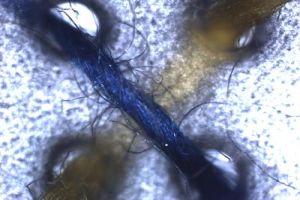ACS Press ReleaseThread as a versatile material for low-cost microfluidic diagnostics19 February 2010
Close up image of cotton thread. Image: Wei Shen
Scientists at Monash are reporting the first use of ordinary
cotton thread and sewing needles to literally stitch together a
microfluidic analytical device — microscopic technology that can
transport fluids for medical tests and other purposes in a
lab-on-a-chip. The chips shrink room-sized diagnostic testing
equipment down to the size of a postage stamp, and promise
revolutionary applications in medicine, environmental sensing,
and other areas. Their study is in ACS Applied Materials &
Interfaces, a monthly journal.
Wei Shen and colleagues note that the development of low-cost
"lab-on-a-chip" diagnostic tests has become an attractive area
of research. Existing devices require etching microscopic
channels onto slivers of silicon, glass, ceramics, or metal in a
costly, complicated process. The scientists set out to find an
alternative, and did so with cotton thread, which wicks fluids
along its tiny fibers.
They stitched thread into paper to form microfluidic sensors
capable of detecting and measuring substances released in the
urine of patients with several human medical conditions. "The
fabrication of thread-based microfluidic devices is simple and
relatively low cost because it requires only sewing needles or
household sewing machines," the report said. "Our results
demonstrate that thread is a suitable material for fabricating
microfluidic diagnostic devices for monitoring human health,
environment and food safety, especially for the population in
less-industrialized areas or remote regions."
Thread can be used to fabricate 3D and semiquantitative microfluidic analytical devices. An advantage of using thread as the liquid transporting channels is that it does not need patterned barriers. Another advantage of using thread or thread with other porous materials such as paper to fabricate microfluidic devices is that these devices can be fabricated with basic tools; the reliance on modern equipment is reduced. "Thread as a Versatile Material for Low-Cost Microfluidic Diagnostics" http://pubs.acs.org/stoken/presspac/presspac/full/10.1021/am9006148
CONTACT:
Wei Shen, Associate Professor Australian Pulp and Paper Institute Department of Chemical Engineering |